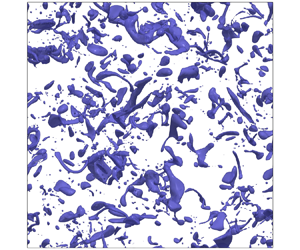Article contents
Fundamental time scales of bubble fragmentation in homogeneous isotropic turbulence
Published online by Cambridge University Press: 03 May 2023
Abstract

We investigate the fundamental time scales that characterise the statistics of fragmentation under homogeneous isotropic turbulence for air–water bubbly flows at moderate to large bubble Weber numbers,  $We$. We elucidate three time scales:
$We$. We elucidate three time scales:  $\tau _r$, the characteristic age of bubbles when their subsequent statistics become stationary;
$\tau _r$, the characteristic age of bubbles when their subsequent statistics become stationary;  $\tau _\ell$, the expected lifetime of a bubble before further fragmentation; and
$\tau _\ell$, the expected lifetime of a bubble before further fragmentation; and  $\tau _c$, the expected time for the air within a bubble to reach the Hinze scale, radius
$\tau _c$, the expected time for the air within a bubble to reach the Hinze scale, radius  $a_H$, through the fragmentation cascade. The time scale
$a_H$, through the fragmentation cascade. The time scale  $\tau _\ell$ is important to the population balance equation (PBE),
$\tau _\ell$ is important to the population balance equation (PBE),  $\tau _r$ is critical to evaluating the applicability of the PBE no-hysteresis assumption, and
$\tau _r$ is critical to evaluating the applicability of the PBE no-hysteresis assumption, and  $\tau _c$ provides the characteristic time for fragmentation cascades to equilibrate. By identifying a non-dimensionalised average speed
$\tau _c$ provides the characteristic time for fragmentation cascades to equilibrate. By identifying a non-dimensionalised average speed  $\bar {s}$ at which air moves through the cascade, we derive
$\bar {s}$ at which air moves through the cascade, we derive  $\tau _c=C_\tau \varepsilon ^{-1/3} a^{2/3} (1-(a_{max}/a_H)^{-2/3})$, where
$\tau _c=C_\tau \varepsilon ^{-1/3} a^{2/3} (1-(a_{max}/a_H)^{-2/3})$, where  $C_\tau =1/\bar {s}$ and
$C_\tau =1/\bar {s}$ and  $a_{max}$ is the largest bubble radius in the cascade. While
$a_{max}$ is the largest bubble radius in the cascade. While  $\bar {s}$ is a function of PBE fragmentation statistics, which depend on the measurement interval
$\bar {s}$ is a function of PBE fragmentation statistics, which depend on the measurement interval  $T$,
$T$,  $\bar {s}$ itself is independent of
$\bar {s}$ itself is independent of  $T$ for
$T$ for  $\tau _r \ll T \ll \tau _c$. We verify the
$\tau _r \ll T \ll \tau _c$. We verify the  $T$-independence of
$T$-independence of  $\bar {s}$ and its direct relationship to
$\bar {s}$ and its direct relationship to  $\tau _c$ using Monte Carlo simulations. We perform direct numerical simulations (DNS) at moderate to large bubble Weber numbers,
$\tau _c$ using Monte Carlo simulations. We perform direct numerical simulations (DNS) at moderate to large bubble Weber numbers,  $We$, to measure fragmentation statistics over a range of
$We$, to measure fragmentation statistics over a range of  $T$. We establish that non-stationary effects decay exponentially with
$T$. We establish that non-stationary effects decay exponentially with  $T$, independent of
$T$, independent of  $We$, and provide
$We$, and provide  $\tau _r=C_{r} \varepsilon ^{-1/3} a^{2/3}$ with
$\tau _r=C_{r} \varepsilon ^{-1/3} a^{2/3}$ with  $C_{r}\approx 0.11$. This gives
$C_{r}\approx 0.11$. This gives  $\tau _r\ll \tau _\ell$, validating the PBE no-hysteresis assumption. From DNS, we measure
$\tau _r\ll \tau _\ell$, validating the PBE no-hysteresis assumption. From DNS, we measure  $\bar {s}$ and find that for large Weber numbers (
$\bar {s}$ and find that for large Weber numbers ( $We>30$),
$We>30$),  $C_{\tau }\approx 9$. In addition to providing
$C_{\tau }\approx 9$. In addition to providing  $\tau _c$, this obtains a new constraint on fragmentation models for PBE.
$\tau _c$, this obtains a new constraint on fragmentation models for PBE.
JFM classification
- Type
- JFM Papers
- Information
- Copyright
- © The Author(s), 2023. Published by Cambridge University Press
References
- 3
- Cited by





